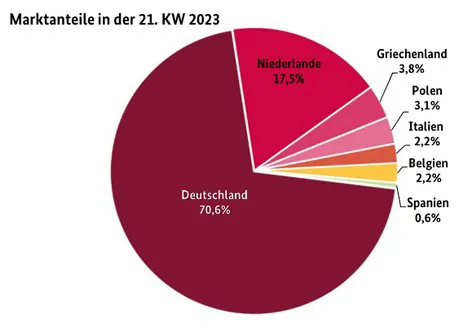Domestic strawberries clearly dominated the markets. Dutch goods came second. Lots from Greece, Poland, Belgium, Italy, and Spain arrived only sporadically and were all of a merely supplementary nature. According to the BLE, deliveries from the domestic market, now from the open ground as well, increased. Demand could not always keep pace with this. Traders increased their prices on various occasions at the start of the week, but they were then often forced to successively lower their previous prices if they wanted to avoid larger surpluses. However, even with the discounts granted, stocks could not always be avoided. 
In Hamburg, goods came in from the west and south of Germany, some of which had already arrived on the market with conditional problems as a result of poor regional weather conditions during growth. These impaired the trade of regular goods. Cologne reported slight price increases at the beginning of the week, but these could not be maintained due to extended deliveries.
Apples
Domestic batches from CA warehouses continued to dominate, with Italian playing the largest role behind them. Deliveries from France and the Netherlands still held some market share. Availability of European batches slowly declined in line with seasonal levels. Nevertheless, demand could generally be met without effort.
Pears
South African goods outweighed Chilean and Argentinean ones. Imports from the southern hemisphere were thus firmly in control of the stores. These were the most convincing in terms of quality. Overall, trading was fairly slow.
Table grapes
Chilean imports set the tone, Thompson Seedless and Crimson Seedless in particular. These were slightly more expensive in some cases. The presence of South African batches was limited. The importance of Italian fruit, on the other hand, obviously increased.
Peaches and nectarines
Spanish items formed the basis of the range, flanked only by small Italian volumes. Mainly yellow-fleshed fruits were available. White-fleshed ones were an exception. The products were sometimes too small, and in some places, the taste left much to be desired, which of course, made them difficult to accommodate.
Apricots
Spanish fruits dominated, complemented by Italian ones. Turkish as well as French items held only a supplementary status, with the latter making their first appearance this season and meeting with some friendly attention. In general, availability had increased.
Lemons
Spanish Verna predominated and were most likely to be accompanied by South African Eureka. Italian, Turkish, and Greek deliveries were sporadic. Supplies expanded and were easily sufficient to meet demand.
Bananas
Supply and demand generally balanced each other out sufficiently so that prices did not change significantly. Only in Munich did prices rise slightly for the entire range; this was caused by slightly too tight availability.
Cauliflower
Thanks to increased deliveries, local offers had displaced French articles from the top of the product range. The latter had lost relevance and, in some cases, also revealed conditional deficiencies. Belgian and Dutch deliveries supplemented this.
Lettuce
In the case of lettuce, only domestic and Belgian lots could be accessed at previous demands. Variegated lettuce also came from Germany and Belgium. Despite a nice demand, prices trended downward rather than upward due to increased supplies.
Cucumbers
Belgian, Dutch, and domestic cucumbers dominated the market. While availability had been limited, prices still often showed a downward trend as interest was somewhat weak.
Tomatoes
Dutch and Belgian shipments dominated. The range was completed primarily by deliveries from Italy, Germany, France, and Turkey. Supply grew, and locally outstripped demand. This inevitably led to falling prices.
Sweet peppers
The Netherlands and Belgium provided red as well as yellow and green offerings, while only green and red were found among Turkish products. Domestic items played only a minor role. In general, distributors often had to adjust their previous prices.
Asparagus
Domestic deliveries predominated for both purple and white spears and green asparagus. Availability expanded massively and outstripped accommodation. Demand was rather weak, especially at the beginning of the week. Prices trended downwards in various cases.
Source: BLE
